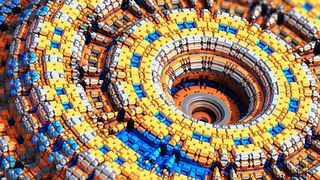
You know those clickbait headlines like “How to [do something incredible] with this 1 weird trick”, or “This insanely easy [something] will change your life forever”, well many would suggest that the Method of Loci (aka “The Memory Palace”, aka The Mind Palace technique”) is one of those ‘crazy’ life-hacks, sort of.
The Ancient Greeks didn’t have cloud tools, smartphones, USB’s capable of housing small libraries or even endless reams of papyrus at their disposal. As such, they had to rely on their memories an awful lot more than we do today.
According to legend (passed on by Cicero, 106 – 43 BCE), the Greek poet and wise man Simonides (556 - 468 BCE) had just presented a lyric poem during a banquet in Thessaly. He was called outside just after his performance when the roof of the banquet hall caved in, crushing all of the diners and mangling their corpses beyond recognition. Simonides, well versed in the art of memory, was able to identify the remains of the guests (important for proper burial) based on knowing the order in which they sat.
While this legend, like most legends, is probably strongly rooted in hyperbole, we do know that many of the Ancient Greeks were very accomplished at remembering stuff.
In a very basic sense, the Method of Loci (loci = place) is a technique used to enhance memory. The central ideas of the technique are that you use visualization (storing/encoding information as pictures) and spatial memory (you mentally place the pictures in a familiar mental environment). This allows for efficient recall, by simply mentally traveling around the environment and decoding what you see into interpretable information.
This might sound like flakey astral-travelling communing-with-nature pseudo-crap, but bear with me.
A few years ago I saw this guy on TV memorise the order of a deck of playing cards. It took him just over a minute. At the time I quickly dismissed it as a setup; a silly TV trick. Last year a friend of mine showed me a youtube clip of this guy doing a similar thing, and then explaining how to do it. This was pretty cool so I started reading bit about it.
The World Memory Championships has been running for 25 years now. Each year participants from all around the world come together to try and remember more names, faces, numbers or words than anyone else. What’s interesting about the competitors is that, despite consistently performing absolutely astounding feats of memory, if you ever see an interview with any of them (or any kind of memory expert that performs impressive feats of recall) they will almost invariably tell you that they have average (or below average) memories, and so do all of the other competitors. Their perceived skill, they will say, comes from having enhanced their memory through training, and of course knowing HOW to ‘train’. The specific techniques they use vary, but all are based on the very simple idea of visualization.
The efficacy of thinking in pictures is well supported by research.
I’ll give you an example of how this works.
I imagine the following story, as vividly as possible.
I’m standing at the front door of my house when a big giant apple with razor-sharp teeth comes running at me. I can see the apple juice dripping down his chin but just as he reaches me I bite into him (he tastes delicious) and he stops dead in his tracks. Next I walk in my front door and see Johnny Depp (dressed as Willy Wonka) standing on my kitchen table throwing chocolate balls at me. I feel confused. I dodge the chocolate balls (ducking and weaving like I’m in The Matrix) and shield myself with an abnormally large piece of bread, which I steal from Cookie Monster. He just happens to be sitting nearby clasping a hamper full of Cookies and bread. I can really feel the texture of his blue fur. The butter on the bread makes the chocolate stick to it like glue, making a very weird looking piece of bread. While I am shielding myself I hear the sound of a harmonica nearby. A big fish is standing up in a pan in the sink play his harmonica and trying to tune it at the same time. It sounds horrible but distracts me from Johnny. In order to silence the fish I try and strangle him with a long rope-like piece of spaghetti. I have to wrap it around him about 50 times but he eventually stops playing the harmonica. I figure it’s time for a snack so I go to the fridge and open it with a violent tug but a huge wave of mayonnaise comes pouring out. As it washes over me I can taste the creamy egg, and I realize it’s stained my blue shirt so I take it off and go to the laundry. We have a weird system in our house whereby instead of washing clothes we give them to Popeye and he punches the clothes clean. While I’m trying to hand my shirt to Popeye I accidentally step on my cat’s tail. She hisses at me and bites my leg. She must really be hungry, so I decide to give her some mince I happen to have in my pocket.
Finish
This story probably sounds quite stupid, and it is. That’s the point. Have you ever gone shopping and had a list of items to remember? Everyone has. We just ‘made’ a list of 14:
- Apples (big giant man-eating ones)
- Razors (with razor-sharp teeth)
- Chocolate (thrown by Willy Wonka)
- Cookies (being held tightly by Cookie Monster
- Bread (used to shield against the chocolate attack)
- Glue (the chocolate sticks to the bread-shield)
- Tuna (the fish playing and tuning the harmonica)
- Rope (spaghetti wrapping around the fish)
- Spaghetti (spaghetti wrapping around the fish)
- Mayonnaise (pouring out of the fridge)
- Eggs (part of the mayonnaise)
- Spinach (Popeye…)
- Cat food (the cat is hungry enough to bite me)
- Mince (for the cat)
Read the story again slowly, and mentally see everything that is described.
Admittedly, this story took me a few minutes to create, and probably a few minutes to read. However, I’m fairly confident that most people, after reviewing this story a few times (and visualizing it) will be able list the items with near perfect recall.
Theoretically our short-term memories are only capable of holding 7 (+/- 2) items, remembering 14 is clearly impressive. But a really important part of this technique is that your visualizations must be vivid. The more stupid, wacky, bizarre, funny or ‘memorable’ you can make the images, the better. The more sensory information you can incorporate, the better. I try and imagine the smells, how something feels, sounds or tastes, and even how it makes me feel emotionally.
This might all seem like way too much effort. It did take me a while to write this story, but that’s largely because I’m a fairly slow typist. To come up with the story (and make the associations, visual images etc.) doesn’t take long at all. You can probably see that this generic visualization technique can be applied to remembering names, faces, strings of numbers/dates, words, poems – you are really only bound by your imagination.
Memory experts really proficient at visualization techniques can create their story almost instantly. Once you have done this a few times you should be able to review your story (mentally walk through the scene you have created in your mind) in next to no time. Not only is this technique efficient, it’s really really convenient.
I’ve only scratched the surface here, but this is an incredibly powerful technique.




